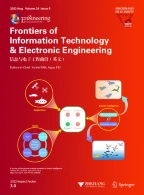174Accesses
1Citation
Abstract
Steering control for an autonomous underwater glider (AUG) is very challenging due to its changing dynamic characteristics such as payload and shape. A good choice to solve this problem is online system identification via in-field trials to capture current dynamic characteristics for control law reconfiguration. Hence, an online polynomial estimator is designed to update the yaw dynamic model of the AUG, and an adaptive model predictive control (MPC) controller is used to calculate the optimal control command based on updated estimated parameters. The MPC controller uses a quadratic program (QP) to compute the optimal control command based on a user-defined cost function. The cost function has two terms, focusing on output reference tracking and move suppression of input, respectively. Move-suppression performance can, at some level, represent energy-saving performance of the MPC controller. Users can balance these two competitive control performances by tuning weights. We have compared the control performance using the second-order polynomial model to that using the fifth-order polynomial model, and found that the former cannot capture the main characteristics of yaw dynamics and may result in vibration during the flight. Both processor-in-loop (PIL) simulations and in-lake tests are presented to validate our steering control performance.
This is a preview of subscription content,log in via an institution to check access.
Access this article
Subscribe and save
- Get 10 units per month
- Download Article/Chapter or eBook
- 1 Unit = 1 Article or 1 Chapter
- Cancel anytime
Buy Now
Price includes VAT (Japan)
Instant access to the full article PDF.
Similar content being viewed by others
References
Alvarez, A., Caffaz, A., Caiti, A.,et al., 2009. Fòlaga: a low-cost autonomous underwater vehicle combining glider and AUV capabilities.Ocean Eng.,36(1): 24–38. https://doi.org/10.1016/j.oceaneng.2008.08.014
Caccia, M., Indiveri, G., Veruggio, G., 2000. Modeling and identification of open-frame variable configuration un-manned underwater vehicles.IEEE J. Ocean. Eng.,25(2): 227–240. https://doi.org/10.1109/48.838986
Chen, H.T., 1981. Submarine Maneuverability. National De-fense Industry Press, Beijing (in Chinese).
Eng, Y.H., Teo, K.M., Chitre, M.,et al., 2016. Online system identification of an autonomous underwater vehicle via in-field experiments.IEEE J. Ocean. Eng.,41(1): 5–17. https://doi.org/10.1109/JOE.2015.2403576
Eriksen, C.C., Osse, T.J., Light, R.D.,et al., 2001. Seaglider: a long-range autonomous underwater vehicle for oceano-graphic research.IEEE J. Ocean. Eng.,26(4): 424–436. https://doi.org/10.1109/48.972073
Graver, J.G., 2005. Underwater Gliders: Dynamics, Control and Design. PhD Thesis, Princeton University, New Jer-sey, USA.
Isa, K., Arshad, M.R., Ishak, S., 2014. A hybrid-driven un-derwater glider model, hydrodynamics estimation, and an analysis of the motion control.Ocean Eng.,81: 111–129. https://doi.org/10.1016/j.oceaneng.2014.02.002
Leonard, N.E., Graver, J.G., 2001. Model-based feedback control of autonomous underwater gliders.IEEE J. Ocean. Eng.,26(4): 633–645. https://doi.org/10.1109/48.972106
Li, J., Lu, C.J., Huang, X., 2010. Calculation of added mass of a vehicle running with cavity.J. Hydrodynam. Ser. B,22(3): 312–318. https://doi.org/10.1016/S1001-6058(09)60060-3
Li, T.S., 1999. Torpedo Maneuverability. National Defense Industry Press, Beijing (in Chinese).
Liu, Y., Shen, Q., Ma, D.L.,et al., 2016. Theoretical and experimental study of anti-helical motion for underwater glider.Appl. Ocean Res.,60: 121–140. https://doi.org/10.1016/j.apor.2016.09.001
Mišković, N., Vukić, Z., Bibuli, M.,et al., 2011. Fast in-field identification of unmanned marine vehicles.J. Field Robot.,28(1): 101–120. https://doi.org/10.1002/rob.20374
Phoemsapthawee, S., Le Boulluec, M., Laurens, J.M.,et al., 2011. Numerical study on hydrodynamic behavior of an underwater glider. Proc. 30th Int. Conf. on Ocean, Off-shore and Arctic Engineering, p.521–526. https://doi.org/10.1115/OMAE2011-49670
Phoemsapthawee, S., Le Boulluec, M., Laurens, J.M.,et al., 2013. A potential flow based flight simulator for an un-derwater glider.J. Mar. Sci. Appl.,12(1): 112–121. https://doi.org/10.1007/s11804-013-1165-x
Rentschler, M.E., Hover, F.S., Chryssostomidis, C., 2006. System identification of open-loop maneuvers leads to improved AUV flight performance.IEEE J. Ocean. Eng.,31(1): 200–208. https://doi.org/10.1109/JOE.2005.858369
Rudnick, D.L., Davis, R.E., Eriksen, C.C.,et al., 2004. Un-derwater gliders for ocean research.Mar. Technol. Soc. J.,38(2): 73–84. https://doi.org/10.4031/002533204787522703
Schmid, C., Biegler, L.T., 1994. Quadratic programming methods for reduced Hessian SQP.Comput. Chem. Eng.,18(9): 817–832. https://doi.org/10.1016/0098-1354(94)E0001-4
Shi, S.D., 1995. Submarine Maneuverability. National De-fense Industry Press, Beijing (in Chinese).
Tiano, A., Sutton, R., Lozowicki, A.,et al., 2007. Observer Kalman filter identification of an autonomous underwater vehicle.Contr. Eng. Pract.,15(6): 727–739. https://doi.org/10.1016/j.conengprac.2006.08.004
Wang, S.X., Sun, X.J., Wang, Y.H.,et al., 2011. Dynamic modeling and motion simulation for a winged hybrid-driven underwater glider.China Ocean Eng.,25(1): 97–112. https://doi.org/10.1007/s13344-011-0008-7
Xiao, Z.R., 2014. Calculation of submarine’s inertial hydro-dynamics coefficient.J. Nav. Univ. Eng.,26(5): 44–47 (in Chinese).
Zhang, F.T., Tan, X.B., 2015. Passivity-based stabilization of underwater gliders with a control surface.J. Dynam. Syst. Meas. Contr.,137(6): 1–13. https://doi.org/10.1115/1.4029078
Zhang, F.T., Zhang, F.M., Tan, X.B., 2014. Tail-enabled spiraling maneuver for gliding robotic fish.J. Dynam. Syst. Meas. Contr.,136(4): 1–8. https://doi.org/10.1115/1.4026965
Author information
Authors and Affiliations
School of Aeronautic Science and Engineering, Beihang University, Beijing, 100191, China
You Liu & Dong-li Ma
Institution of China Academy of Aerospace Aerodynamics, Beijing, 100074, China
You Liu, Qing Shen & Xiang-jiang Yuan
- You Liu
You can also search for this author inPubMed Google Scholar
- Qing Shen
You can also search for this author inPubMed Google Scholar
- Dong-li Ma
You can also search for this author inPubMed Google Scholar
- Xiang-jiang Yuan
You can also search for this author inPubMed Google Scholar
Corresponding author
Correspondence toXiang-jiang Yuan.
Additional information
Project supported by Beihang University and Institution of China Academy of Aerospace Aerodynamics
Rights and permissions
About this article
Cite this article
Liu, Y., Shen, Q., Ma, Dl.et al. Steering control for underwater gliders.Frontiers Inf Technol Electronic Eng18, 898–914 (2017). https://doi.org/10.1631/FITEE.1601735
Received:
Accepted:
Published:
Issue Date:
Share this article
Anyone you share the following link with will be able to read this content:
Sorry, a shareable link is not currently available for this article.
Provided by the Springer Nature SharedIt content-sharing initiative
Key words
- Autonomous underwater glider (AUG)
- Online system identification
- Steering control
- Adaptive control
- Optimal control
- Energy saving control
- Processor-in-loop (PIL)


